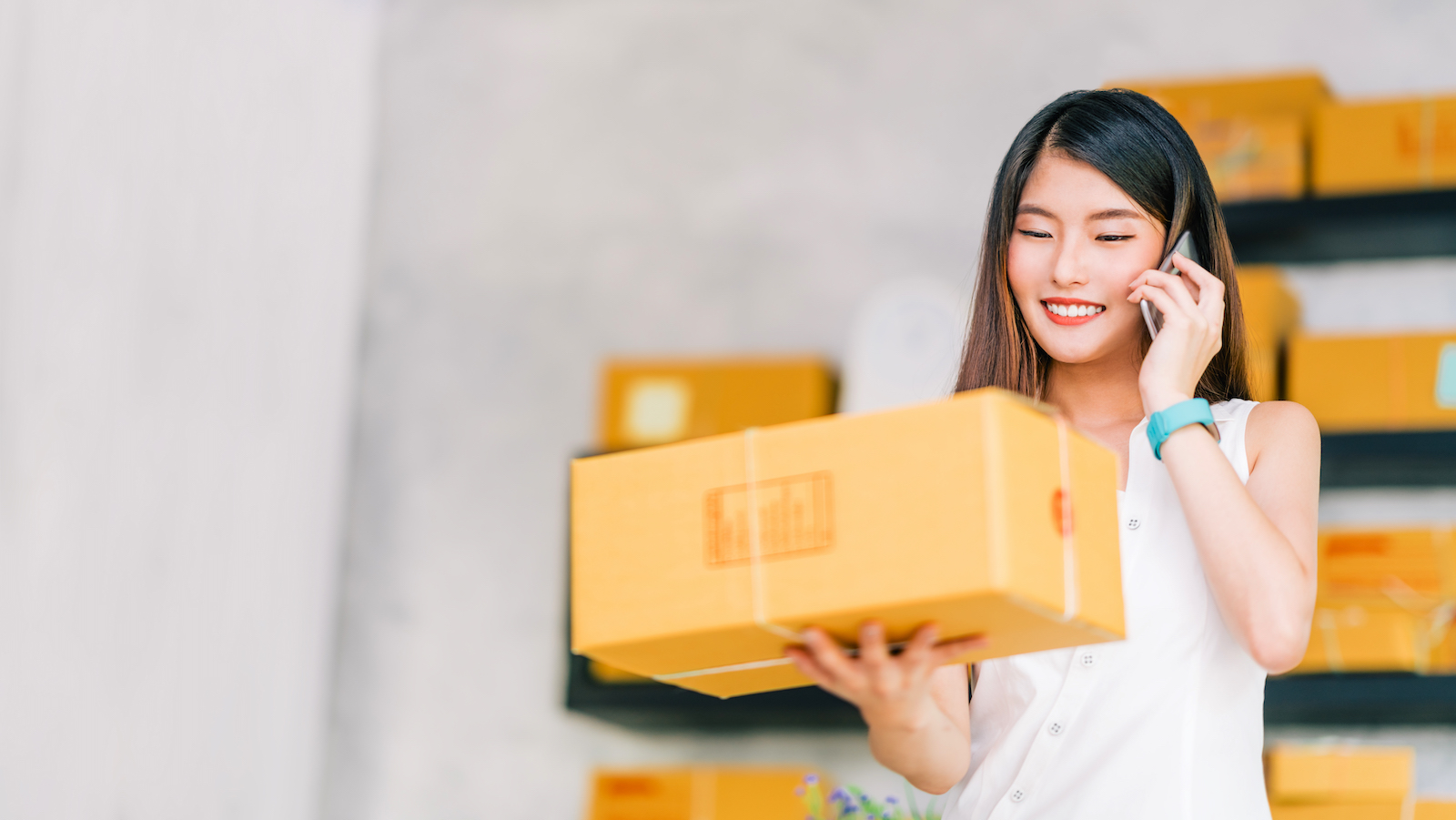Table of Contents
** Minutes
Consumer expectations on the shipping experience
Why creating a memorable shipping experience is important
10 ways to improve the ecommerce shipping experience
How 3PLs allow you to offer the shipping experience your customers expect
Speed, visibility, accuracy, and affordability — this is the formula for a positive shipping experience.
Though many online brands focus most of their attention on attracting customers, the post-purchase experience is just as important. Yet when it comes to logistics operations, more than 53% of retailers claim shipping to be a significant challenge.
Fortunately, there are accessible ways to optimise your shipping strategy to enhance the shipping experience for your customers.
In this article, you will learn the importance of creating a positive shipping experience, and how you can optimise your fulfilment strategy to meet customer expectations.
Consumer expectations on the shipping experience
Marketplaces like Amazon and Walmart have set the standard for fast, affordable shipping. With online shoppers expecting fast shipping on all purchases, on-demand logistics has never been more important, especially for direct-to-consumer (DTC) brands.
Customers expect a hassle-free experience when it comes to shipping. Here are the facts:
- 83% of online shoppers expect regular communication about their orders.
- 43% of shoppers abandon their carts due to high shipping costs.
- 73% of online shoppers say free shipping is the most important factor at checkout.
With shipping speed and affordability on the top of shoppers’ minds, fast-growing brands often utilise shipping as part of their marketing strategy to attract more shoppers and turn them into loyal customers.
By offering different shipping options and incentives, such as 2-day shipping or free shipping, you can significantly lower cart abandonment and encourage brand loyalty.
Why creating a memorable shipping experience is important
The shipping experience impacts both sales conversion and customer retention. If online shoppers are unsatisfied with your shipping options and costs, as well as final delivery, they are unlikely to purchase from you again.
Here is a deeper dive on why creating a memorable shipping experience is important for business growth.
Cultivate lasting customer relationships
A positive customer shipping experience creates a long-lasting impression. The shipping and delivery experience is also the only chance most ecommerce brands have to physically ‘interact’ with customers. Every step, from order processing to picking and packing items, influences the shipping experience.
If you can maintain a positive shipping experience by finding ways to improve supply chain efficiency, you can earn trust and stay competitive.
Increase conversion rates
The shipping experience begins on your website, including your messaging and which shipping options customers see when they reach checkout.
Providing fast, affordable shipping can significantly increase purchase rates, so many brands use desirable shipping options as a marketing tool.
For instance, adding a sitewide banner at the top of your website above the navigation is a great tactic with top key message proven to move the needle being around free shipping.
Customers are often willing to spend more money to meet a minimum cart threshold to qualify for free shipping. Other ways to increase conversion rates include a faster shipping option. And by storing inventory closer to your customers, you can enable affordable 2-day shipping via ground.
Learn more about how free shipping incentives can influence purchase decisions.
10 ways to improve the ecommerce shipping experience
To keep customers satisfied and coming back for more, here are ten ways you can improve the ecommerce shipping experience.
1. Offer multiple shipping options
Some retailers offer customers only one way of shipping items. This could leave the customer unsatisfied if this option is not conducive for them (e.g., when they are in a time crunch and are desperate to get a product like yours quickly).
It’s a common best practice to offer customers multiple shipping options, including 2-day shipping, and sometimes even expedited shipping, overnight shipping, and same-day delivery.
Offering multiple shipping options, including premium shipping, can seem out of reach for smaller ecommerce brands. But there are several logistics solutions for businesses of all sizes to offer a variety of shipping options — including global shipping.
For instance, ShipBob is an international fulfilment 3PL that powers its entire distribution network with the same best-in-class technology.
With ShipBob, you can split inventory across locations based on where their customers are located. That way, when orders are placed on your online store, it is routed to the nearest fulfilment centre location. If a customer resides in a low shipping zone (or same zone as the fulfilment centre), the customer may get 2-day shipping without paying an arm and leg for it.
“We want the customer experience of purchasing on our website to be similar to Amazon Prime. This is possible with ShipBob, without inflating the shipping cost to an insane level. To do this, we strategically place products around the country.
We are storing inventory in three of ShipBob’s fulfilment centres: Moreno Valley, California; Chattanooga, Tennessee; and Dallas, Texas. These locations map out nicely with our customer base as we have a large group in the South and also get coverage on the West Coast and in the Midwest.”
Tim Fink, Co-Founder of EnduroSport
ShipBob also partners with major global and regional parcel couriers, which enables more shipping options for merchants while optimising shipping costs and transit times.
Be sure to always offer affordable options, such as ground shipping, if cost takes priority over delivery speed.
2. Stick to shipping times (don’t be late)
Like any good relationship, communication is key. Be sure to ship orders within the same timelines listed on your shipping policy. Be fully transparent of estimated shipping dates, with or without delays.
If there are any last-mile delivery delays, it’s important to notify your customers right away. While some delays are preventable, most delays during transit are out of your control; still, your customers will appreciate timely updates.
3. Provide shipping tracking updates
Ecommerce order tracking is a high priority. Customers expect to have visibility that’s accessible. Once an order is shipped, you will need to implement a way to send tracking information automatically to your customers.
When you automate shipmenttracking updates, you can also save time by minimising the amount of questions coming in from customers regarding order status. This frees up your ecommerce customer service team to focus on more pressing issues.
Utilising shipping tracking with customers strengthens your relationship with them. It shows you are willing to be transparent with them, which ultimately builds trust.
4. Deliver accurate orders
Even if a shipment arrives on time, opening a package with the wrong items can put a damper on the unboxing experience. Make sure you have the right order fulfilment processes in place to reduce order packing errors.
There are steps you can take to improve order accuracy, such as implementing real-time inventory tracking to ensure you have the items ordered readily available, or you can look for ways to optimise your warehouse space to simplify the picking and packing process.
If you currently fulfil orders in-house, but you struggle to keep up with demand, it will become more of a challenge to sustain a high order accuracy rate. Though reaching 100% accuracy isn’t realistic, you should strive to maintain an accuracy rate between 96%-98%.
If your current accuracy rate is lower than 95%, it might be time to outsource fulfilment and shipping to a third-party logistics (3PL) provider like ShipBob.
“Logistics is something you never think about until it stops working, and we’ve never come to that point with ShipBob. Everything just works. We are super happy with ShipBob and very impressed by how well they’ve pumped out our large volume of orders.”
Sergio Tache, CEO of Dossier
5. Work on flexible return policies
Returns are inevitable, and they don’t typically mean a customer is satisfied. However, you can look at returns as an opportunity to enhance the customer experience.
In your ecommerce return policy, always provide clear instructions for customers to understand how to initiate a return and send orders back without any extra hassles. It’s also important to communicate honestly about what to expect, including returns costs (if any), replacement items, store credits, and delivery times once products are returned.
There are several ways to improve your returns management process to establish a customer-friendly return policy, so customers feel more comfortable purchasing from you again, knowing returns are taken care of efficiently. In fact, 92% of customers who are satisfied with the return process will continue shopping with you.
About a year and a half after building out our business, we figured it was time to optimise some of our processes, including returns. The ability to work with one of the co-founders of ShipBob to launch a new, custom returns process was awesome.
Returns were taking a lot of time and resources to process on our end, but ShipBob was super helpful and critical in creating a solution for us.”
Nikolai Paloni, Co-Founder of Ombraz Sunglasses
6. Make the shipping process personalised
Since it’s important to communicate with your customers throughout the post-purchase stage, why not personalise messaging to further engage your customers?
You can personalise the shipping process by putting extra effort into your transactional emails, including fun messaging and design. For instance, you can add eye-catching animation and or even discounts to encourage shoppers to come back and spend more sooner than later.
Feel free to have fun experimenting with emails, including order confirmation, shipping details, and order updates. Just be sure to keep the subject lines straightforward so customers don’t miss them. You can also add gift notes, marketing inserts, and include giveaways or unexpected bonuses to delight your customers.
7. Consider shipping subscriptions
A subscription fulfilment strategy offers customers the option to have orders automatically refilled on a predetermined, recurring basis.
By offering a subscription box service, customers can get ingredients delivered to make a fresh meal, freshen up their wardrobe without rummaging through racks, or easily stay on top of their essential needs.
Subscription services offer an option for customers to ‘subscribe and save’ by having them commit upfront for a discount, rather than pay full price each time they reorder (or spend more money upfront and instead pay when they get the next batch of your product, without having to run to the store or remember to place another order).
While subscriptions offer a way for customers to save money, you’re given a monthly, quarterly, or yearly baseline of income and the additional revenue quickly offsets the discount given.
“Our business is almost all subscriptions, and ShipBob helps us offer reliable, affordable shipping that shows up at the same time each month. We offer a free one-month supply as part of our initial three-month personalised acne treatment kit from our app.”
Oded Harth, CEO & Co-Founder of MDacne
8. Switch to sustainable shipping options
More than ever before, customers are concerned with how shipping can impact the environment. 70% of consumers believe purchasing from a sustainable or eco-friendly brand is important.
Switching to a more eco-friendly shipping approach includes incorporating more eco-friendly packaging options, like compostable and recyclable packaging. Using eco-friendly packaging is becoming more common as more customers are looking for eco-friendly brands to purchase from.
To implement green ecommerce shipping, you can utilise carbon-neutral shippingor even outsource fulfilment to an eco-friendly fulfilment provider like ShipBob.
ShipBob partners with Ecocart so you can purchase carbon credits by allowing your customers to choose (and optionally, pay for) carbon offsets on a per-order basis, and allowing you to offset the carbon impact of product manufacturing and even last-mile delivery.
“Our goal was simple: offset carbon emissions. In our search for the right partner, ShipBob was proactive. We can now share accurate data with our customers regarding the success of our reforestation initiatives.”
Michael Klein, Co-Founder at Herbaly
9. Personalise your packaging
Personalising your product packaging is a great way to delight your customers once an order is delivered. The extra effort will feel personalised for that customer, helping ensure loyalty to your brand.
With custom branded packaging, you also have an opportunity to increase brand recognition and generate positive social proof. Since the unboxing experience is thoughtful and unique, customers are more likely to want to share their experience with others, especially on social media.
10. Ask your customers for feedback
To continuously improve the shipping experience, once orders are delivered, it’s always a good idea send an email asking how the delivery went. You can set these types of emails up to be automatic, so they are delivered in a timely manner.
Asking for feedback will help you further optimise the your supply chain and focus on the areas that need the most attention. It’s also best practice to keep an eye on customer reviewsabout your brand online and respond to any negative shipping experiences. It’s never too late to turn an experience around. Ultimately, customers want to be heard and validated.
How 3PLs allow you to offer the shipping experience your customers expect
You can implement the steps above in your business, but it can also take a lot of extra time and money. However, when partnering with a 3PL like ShipBob, you can worry less about logistics while improving the shipping experience.
ShipBob offers the fulfilment infrastructure and technology you need, so you can reduce shipping costs and transit times to better meet customer expectations around their shipping experience.
With ShipBob, you can put the retail fulfilment and shipping operations on autopilot, while freeing up time to focus on growing your business.
ShipBob even integrates directly with the leading ecommerce customer service and helpdesk platform, Gorgias, allowing brands to have seamless customer support and shipping data in one place to streamline any post-purchase order inquiries and actions.
To learn more about how ShipBob can help your ecommerce business improve the shipping experience, request a fulfilment quote below to start the conversation.
Shipping experience FAQs
Here are the top questions about the ecommerce shipping experience.
How can you improve the shipping experience?
To improve the shipping experience, it starts with offering different shipping options, from affordable ground shipping to expedited air. A common incentive to get customers to purchase is offering a minimum spend threshold (higher than your average order value) for free shipping. Once a customer makes a purchase, it’s important to always send them tracking information and keep them updated on order status, including any possible delays you are aware of.
Why is fast delivery important for the shipping experience?
These days, online shoppers expect fast delivery at an affordable rate. To compete with competitors and major marketplaces like Amazon, offering fast delivery can help you win more customers. Fortunately, it’s possible for DTC brands of all sizes to provide fast delivery to most or all of their customers through fulfilment companies like ShipBob that aim to improve and optimise the shipping experience, without the need for brands to invest in the infrastructure themselves.
Can 3PLs help to improve the shipping experience?
Yes! 3PLs like ShipBob offer large distribution networks and technology that help to improve the shipping experience, while packing orders on behalf of brands to free up their time. ShipBob allows merchants to split inventory across locations to strategically offer more customers 2-day ground shipping. Fulfilment experts take care of the picking and packing of orders and withhold a high order accuracy rate. Orders are then picked up at the 3PL’s fulfilment centre and shipped by various courier partners using the most optimised route for efficiency.



